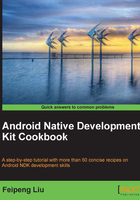
上QQ阅读APP看书,第一时间看更新
Conventions
In this book, you will find a number of styles of text that distinguish between different kinds of information. Here are some examples of these styles, and an explanation of their meaning.
Code words in text are shown as follows: "Windows NDK comes with a new ndk-build.cmd build script."
A block of code is set as follows:
#include <string.h>
#include <jni.h>
jstring
Java_cookbook_chapter1_HelloNDKActivity_naGetHelloNDKStr(JNIEnv* pEnv, jobject pObj)
{
return (*pEnv)->NewStringUTF(pEnv, "Hello NDK!");
}
When we wish to draw your attention to a particular part of a code block, the relevant lines or items are set in bold:
LOCAL_PATH := $(call my-dir)
include $(CLEAR_VARS)
LOCAL_MODULE := framegrabber
LOCAL_SRC_FILES := framegrabber.c
#LOCAL_CFLAGS := -DANDROID_BUILD
LOCAL_LDLIBS := -llog -ljnigraphics -lz
LOCAL_STATIC_LIBRARIES := libavformat_static libavcodec_static libswscale_static libavutil_static
include $(BUILD_SHARED_LIBRARY)
$(call import-module,ffmpeg-1.0.1/android/armv5te)
Any command-line input or output is written as follows:
$sudo update-java-alternatives -s <java name>
New terms and important words are shown in bold. Words that you see on the screen, in menus or dialog boxes for example, appear in the text like this: "Go to Control Panel | System and Security | System | Advanced system settings."